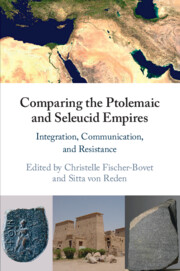Book contents
- Comparing the Ptolemaic and Seleucid Empires
- Comparing the Ptolemaic and Seleucid Empires
- Copyright page
- Contents
- Contributors
- Preface
- Note on Abbreviations
- Maps
- Introduction
- Part I Cities, Settlement and Integration
- Chapter 1 Imperial metropoleis and Foundation Myths
- Chapter 2 Reassessing Hellenistic Settlement Policies
- Chapter 3 The Integration of Indigenous Elites and the Development of poleis in the Ptolemaic and Seleucid Empires
- Chapter 4 Contextualizing a Ptolemaic Solution
- Part II Communication and Exchange
- Part III Collaboration, Crisis, and Resistance
- Bibliography
- Index
Chapter 1 - Imperial metropoleis and Foundation Myths
Ptolemaic and Seleucid Capitals Compared
from Part I - Cities, Settlement and Integration
Published online by Cambridge University Press: 17 September 2021
- Comparing the Ptolemaic and Seleucid Empires
- Comparing the Ptolemaic and Seleucid Empires
- Copyright page
- Contents
- Contributors
- Preface
- Note on Abbreviations
- Maps
- Introduction
- Part I Cities, Settlement and Integration
- Chapter 1 Imperial metropoleis and Foundation Myths
- Chapter 2 Reassessing Hellenistic Settlement Policies
- Chapter 3 The Integration of Indigenous Elites and the Development of poleis in the Ptolemaic and Seleucid Empires
- Chapter 4 Contextualizing a Ptolemaic Solution
- Part II Communication and Exchange
- Part III Collaboration, Crisis, and Resistance
- Bibliography
- Index
Summary
This chapter deals with two different types of capital formation. Alexandria was by far the most important royal city in Egypt. Urban centers in the imperial possessions outside of Egypt never conflicted with the centrality of Alexandria. The Seleucids, by contrast, took over a more heterogeneous, mobile and paradoxically more connected empire with a tradition of several royal cities already established. Identifying a political center is more problematic there, but governance was “a network of ever-shifting, personalized relationships between interest groups and powerful individuals based on reciprocal transactions.” There was a particular need to establish a symbolical political center that was Seleucia-Pieria first, and then Antioch. Both authors observe, however, that it was imperial competition, and to a lesser extent local discourse, that shaped the vision of Ptolemaic and Seleucid capitals. Looking at foundation myths as a guide to the symbolic construction of these capitals, they observe a deeply entangled discourse. Each court and population responded to each other and to Rome in an antagonistic interaction that manifested itself in many other forms than war alone.
Keywords
- Type
- Chapter
- Information
- Comparing the Ptolemaic and Seleucid EmpiresIntegration, Communication, and Resistance, pp. 17 - 47Publisher: Cambridge University PressPrint publication year: 2021



